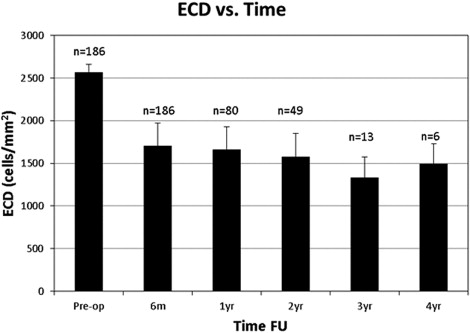Descemet membrane endothelial keratoplasty (DMEK) is one of several surgical options for patients with corneal endothelial disorders. Deep lamellar keratoplasty and Descemet stripping endothelial keratoplasty and Descemet stripping automated endothelial keratoplasty are alternative therapies, and early follow-up data have shown that endothelial cell densities (ECDs) in grafted tissue may be similar in these patients compared with that of those treated with DMEK. Previously, we reported the ECDs in 58 patients 1 to 3 years after DMEK. In the current study, we continued and expanded our analysis on midterm ECDs after DMEK as a measure of long-term Descemet graft survival.
From a larger group of 225 consecutive patients who underwent DMEK for Fuchs endothelial dystrophy or pseudophakic bullous keratopathy, ECD measurements were available in 186 eyes with 6 months of follow-up; 80 also had 12 months of follow-up, 49 had 24 months of follow-up, 13 had 36 months of follow-up, and 6 had 48 months of follow-up ( Supplemental Figure ; Supplemental Table ; available at AJO.com ).
Our findings support a 34% sharp decrease in ECD in the first 6 months after DMEK, followed by a slower decrease of approximately 9% per year sustained over 4 years. This result closely resembles previous reports of a 34% decrease in ECD within 6 months after Descemet stripping endothelial keratoplasty, followed by an 8% decrease between 6 to 24 months. Our updated data showed that the similarity between ECDs in patients after DMEK and earlier types of endothelial keratoplasty is robust over a longer period and with a greater number of patients than has been reported previously. This, combined with evidence that more than three fourths of patients achieve visual acuities of better than 20/25 by 6 months after surgery, may indicate that DMEK could become a preferred treatment method in corneal endothelial disease.
Appendix


Stay updated, free articles. Join our Telegram channel

Full access? Get Clinical Tree


